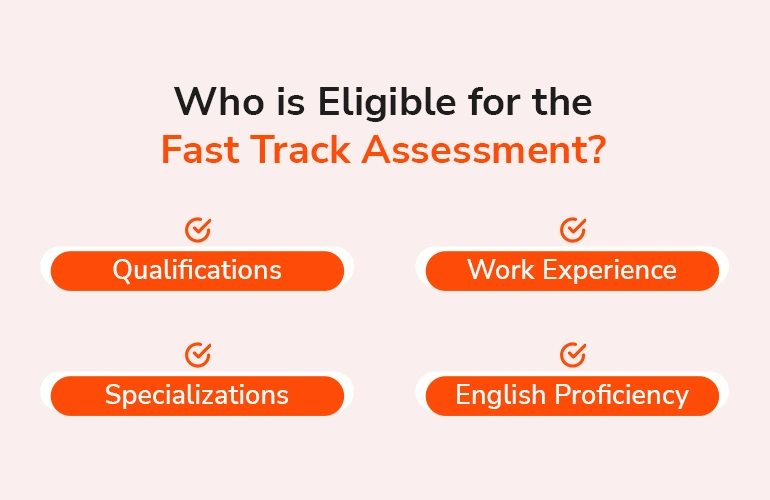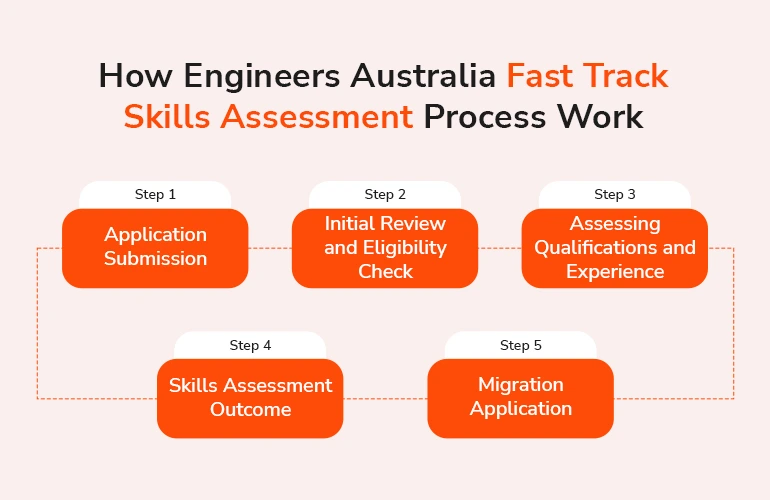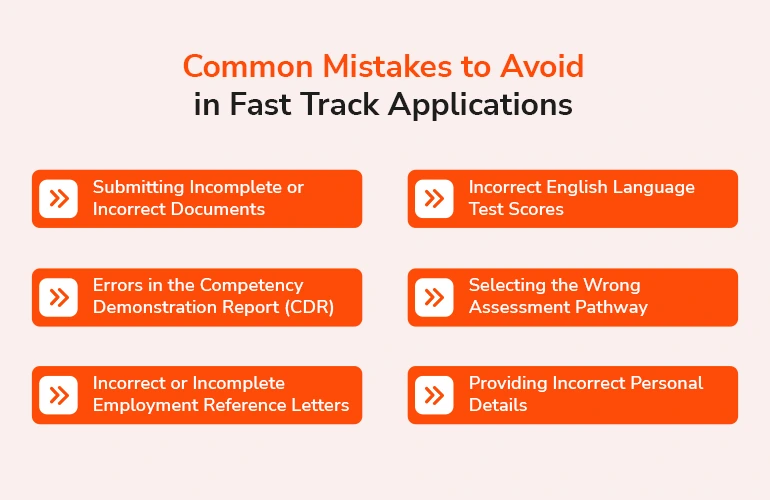What is the Engineers Australia Fast Track Skills Assessment?

What is the Engineers Australia Fast Track Skills Assessment?
Amongst skilled professionals, Australia is one of the main pit stops for engineers, and they tend to have the most era and need of the different engineering specialities because of the robust job market, the high standard of living, and the growing demand for various engineering specialities.
Engineers Australia is a professional organisation that represents the engineers of a whole country and it has a critical role in the process of assessing the skills and qualifications of engineers who are willing to migrate to Australia.
Engineers Australia Fast Track Skills Assessment is the continuation of the assessment of engineers who want to live and work in Australia as part of the broader migration process. It is the process for Australians to achieve the eligibility criteria for migration and the pathways that are of good help to applicants with the Australian immigration system that are difficult to understand.
What is Engineers Australia Fast Track Skills Assessment?
Table of Contents
The Engineers Australia Fast Track Skill Assessment is an expedited scheme for companies that are on the hunt for a skilled workforce in the engineering sector in Australia. This improved process otherwise leads to faster conclusions with such benefits as efficient initiatives for those who must finish their migration duties within a short time.
A reunited method of the Fast Track assessment is by engineers who typically are easy to verify since their qualifications and knowledge are similar to the Australian standards; thus, less information and documentation are necessary.
The engineers’ fast-track assessment is aimed at ensuring that engineers show the necessary qualifications and demonstrate the required competencies for Australian standards, along with supporting successful migration and employment in the country.
Who is Eligible for the Fast Track Assessment?

To qualify for the Engineers Australia Fast Track Skill Assessment, the candidates have to fulfil certain criteria. The requirements are as follows:
1. Qualifications
Applicants ought to have Australian standard equivalences for their engineering qualifications. Acknowledged institutions or countries with reciprocal agreements with Australia will have higher chances for faster assessments of such candidates.
2. Work Experience
The minimum amount of work experience in the relevant engineering discipline is a basic qualification. It is the experience that must prove the applicant’s competence and the ability to shut down engineering tasks effectively in a completely professional working environment.
3. Specialisations
Most often, engineers from those specialisations named civil, mechanical, electrical, and structural engineering are generally the ones that would mostly qualify for the Fast Track assessment in Australia, which is due to the growth of those industries being in high demand.
4. English Proficiency
Involved immigrants, refugees, students, and natives should be able to pass English language proficiency exams such as IELTS, TOEFL, or PTE Academic. Mastery of English is an indispensable tool for effective communication at work and for getting through technical documentation in the engineering field.
How Engineers Australia Fast Track Skills Assessment Process Work

The Fast Track Skill Assessment process is a multi-step procedure where the engineers must adhere to specific rules and regulations of Engineers Australia to get their qualifications and skills recognised.
Step 1: Application Submission
The first procedure in the Fast Track Skill Assessment is to apply Engineers Australia. Occasionally, the applicant must submit the following documents:
a. Educational Qualifications
Records for educational degrees, i.e., the diplomas and related academic papers, etc., which have been submitted by the applicants themselves in the field of engineering.
b. Work Experience
A detailed account of past work can be given by the applicant, including references, job descriptions, and a summary of the tasks done. This will be the evidence required to prove the skills and the experience.
c. Proof of English Proficiency
Information about the applicant’s English language test results, which are recognised.
d. Identification Documents
Passports and other cards to prove identity and rights are some relevant things you will be required to have.
Step 2: Initial Review and Eligibility Check
Ability to Review and Initial Decision: After the application has been submitted, the first natural process that takes place here is the preliminary review by Engineers Australia to ascertain whether the applicant is eligible to get a Fast Track Assessment.
The preliminary procedure involves document checking for validity and checking for eligible criteria compliance through personal verification. At the end of that step, the system will return a message to you warning you to search your inbox for the next command.
Step 3: Assessing Qualifications and Experience
The engineers at Engineers Australia assess the applicant’s competence and use of the work experience and lay down the criteria for the Australian engineering standards for the applicants.
This is a detailed study that encompasses the background of the applicants in the academic field and project experience as well as their technical skills. The assessment will highlight, inter alia, not only the following qualifications, i.e.,
a. Technical Knowledge
The candidate will get high scores for the depth of technical expertise in the chosen engineering field.
b. Problem-Solving Skills
The candidate can identify and solve engineering challenges that every engineer faces in his/her career.
c. Project Management
The candidate has managed engineering tasks from inception through completion.
d. Safety Standards
The candidate is familiar with engineering safety policies and procedures.
Step 4: Skills Assessment Outcome
The assessment completion allows Engineers Australia to deliver official results to the applicant. The results will fall under two categories, which include a successful assessment or additional requirements and an unsuccessful assessment.
A positive skills assessment allows the applicant to receive an entitlement for moving to Thailand since they meet all requirements. The applicant obtains a positive skills evaluation report from Engineers Australia.
Additional evaluation needs to be conducted alongside additional material submission according to Australian standards for the applicant to fulfil requirements.
Candidate assessment fails when the applicant does not meet standards yet gets guidance about necessary changes needed to reapply for coming assessments.
Step 5: Migration Application
Candidates whose Fast Track skill assessment results successfully conclude can file a migration application for Australian immigration. Prospective migrants should file their application for Subclass 189 or Subclass 186 visas as part of their entry process to work legally in Australia.
Advantages of the Fast Track Skill Assessment
Fast Track Skill Assessment provides various perks to candidates through its implementation.
The simplified assessment approach allows engineers to receive decisions more quickly when they want to start their Australian migration process and professional career.
Candidates who possess professional skills that perfectly meet Australian assessment benchmarks have better outcomes in Fast Track assessment evaluations.
Qualified engineers have easier access to Australian migration through the assessment process because it confirms skilled occupation eligibility for both prospective engineers and recruiters.
A successful Fast Track assessment gives engineers international recognition that strengthens their qualifications and enables them to find professional work in Australia.
Required Documents for Fast Track Skills Assessment
1. Personal Identification Documents
a. Passport
Submit a clear digital copy showing your passport identification information page from a valid travel document.
Missing or unavailable passports can be substituted with evidence from either birth certificates or national identity cards.
b. Passport-Size Photograph
A recent colour photograph (similar to passport photos) in JPEG or PNG format.
2. Academic Qualification Documents
a. Degree Certificate(s)
The document that officially grants your highest qualification must be submitted as a scanned version.
A language translation service to English should be provided when the original document appears in another language.
b. Academic Transcripts
A complete set of official academic transcripts provides details about subjects studied along with the received grades, which detail the academic achievements from the university.
The university must provide a confirmation letter in case its academic transcript does not include information about the award of a degree.
3. English Language Proficiency
Candidates need to prove their English ability using one of the recognised language assessments. Engineers need to reach distinct score requirements that vary according to their professional field.
Accepted English Tests:
- IELTS (International English Language Testing System)
- TOEFL iBT (Test of English as a Foreign Language—Internet-Based Test)
- PTE Academic (Pearson Test of English)
- Cambridge English: Advanced (CAE)
4. Work Experience Documents
Professional engineers planning to apply through the Competency Demonstration Report (CDR) Pathway need to show their work experience records.
a. Employment Reference Letters
The letter should display official company letterhead while an authorised person provides the signature.
Should include:
Job title and duties performed.
Start and end dates of employment.
Work location and company details.
The employer’s contact details.
b. Payslips and Contracts
The evaluation process may require future salary payslips and employment contracts together with tax statements as supplementary verification materials.
5. Competency Demonstration Report (CDR)
A competency demonstration report becomes mandatory when the applicant possesses qualifications lacking accreditation from the Washington, Sydney, or Dublin Accords.
CDR Components:
a. Curriculum Vitae (CV/Resume)
The candidate needs to submit a comprehensive CV that shows their educational and employment experience.
b. Career Episodes
The competency demonstration report (CDR) requires written reports about projects and work experiences in engineering.
c. Summary Statement
The document connects competency elements between Engineers Australia guidelines and reports extracted from career professional experiences.
d. Continuous Professional Development (CPD) Statement
The document includes lists of seminars and courses together with details of attended training.
6. Migration Agent Authorization Form (If Using an Agent)
The applicant needs to present an authorised form when a migration agent represents their migration process.
7. Payment Receipt for Fast Track Service
Applicants need to present documented payment of the Fast Track service fees for the government to expedite their application.
Common Mistakes to Avoid in Fast Track Applications
1. Submitting Incomplete or Incorrect Documents
Missing required documents (e.g., passport, degree certificate, transcripts, or employment reference letters).
Applicants present illegible or poor-quality scanned records to the authorities.
The non-provision of translated versions of English-non-English documents by applicants.
How to Avoid:
- Before sending your documents, check the complete list of needed documents twice.
- You need to provide clear document images, which must be both coloured and saved as PDFs.
- The submission requires a certified English translation when you provide documents written in another language.
2. Incorrect English Language Test Scores
Students face rejection when they present expired versions of IELTS, TOEFL, PTE, and Cambridge test results.
Students who do not manage to achieve the required test scores or meet the minimum scoring obligation.
Submitting test reports containing formation errors regarding candidate personal data (name and date of birth, among other things).
How to Avoid:
- Test results should be verified for their current validity, which extends to a maximum of three years.
- Apply scores that meet the required standards for English proficiency.
- Check twice that your information in the application matches all your recorded personal details.
3. Errors in the Competency Demonstration Report (CDR)
The practice of plagiarising career episodes, which originates from online resources, is classified as plagiarism.
The use of unclear or basic career episodes that lack concrete engineering material.
Participants who did not connect their career episodes to Engineers Australia competency elements in their applications.
How to Avoid:
- Develop unique career episodes from your personal engineering work experience.
- Use specific details, calculations, and problem-solving approaches in your reports.
- The summary statement must link accurately to competency elements.
4. Selecting the Wrong Assessment Pathway
Staff from countries that participate in the Washington Accord, Sydney Accord, and Dublin Accord groups mistakenly chose the CDR pathway and thought they should use the Accredited Qualifications pathway.
Non-accredited engineers seek an assessment opportunity by not providing a competency demonstration report.
How to Avoid:
- Verify your qualification status through listings on the Washington, Sydney, and Dublin Accords.
- Engineers need to submit Competency Demonstration Report (CDR) assessments when qualifications do not obtain accreditation.
5. Incorrect or Incomplete Employment Reference Letters
Employment reference letters fail to contain required information, including job positions, work periods, and tasks performed.
No company letterhead, signature, or employer contact information.
The type of work experience lacks relevance to engineering practice.
How to Avoid:
Make sure reference letters contain the following points:
- Official company letterhead and signature.
- Exact job title, employment duration, and detailed responsibilities.
- The reference document must include the employer’s name followed by the job title alongside the designated position and contact information.
6. Providing Incorrect Personal Details
The names do not match your passport and your degree documents, as well as your test scores.
The submission of inaccurate birth dates together with incorrect passport numbers and contact information details.
How to Avoid:
- Students must verify their entire personal information matches properly before giving final approval to their application.
- All documentation must contain a precise match of your official name.
Conclusion
The Engineers Australia Fast Track Skills Assessment provides skilled engineering professionals with an advantageous programme to seek migration to Australia. The programme allows foreign engineers to demonstrate their qualifications and experience through recognition, which shortens the migration process.
Engineers who meet Australian engineering criteria will enhance their opportunity for migration success along with career progression and enduring professional development in Australia.
Engineers who want to use the Fast Track Skill Assessment need to examine the qualification requirements precisely while maintaining precise documentation and must consult experts if they need it.
Engineering professionals can begin their professional journey in Australia by obtaining the Engineers Australia Fast Track Skill Assessment when they prepare correctly with appropriate professional guidance.
Applicants who obtain the Engineers Australia Fast Track Skills Assessment can shorten their migration processing time. Treatment of application errors by candidates can both extend the assessment duration and cause the rejection of their application. A list of applicant-made standard errors includes preventive methods to overcome them.
FAQs
1. How long does Engineers Australia’s skill assessment fast-track processing take?
The Engineers Australia fast-track skills assessment typically takes 3 to 4 weeks, depending on the volume of the application.
2. How long is the Engineers Australia skill assessment valid for?
Engineers Australia’s skills assessment is typically valid for three years from the date it is issued.
3. What is the fast-track visa fee for Australia?
The fast-track fee for Australia is AUD 1,000, which is an additional charge on top of the regular visa application fee.
4. Does Fast Track Guarantee a Positive Outcome?
Fast Track processing does not guarantee a positive outcome for your Skills Assessment with Engineers Australia.





